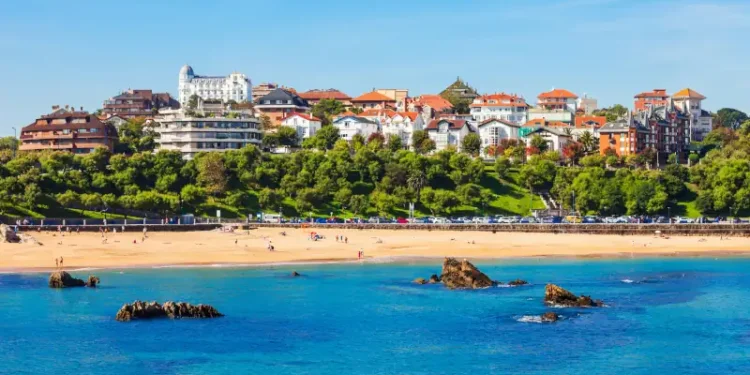With its magnificent view over the Bay of Santander, it’s not surprising that Santander, a small but bustling and interesting city on Spain’s Atlantic Coast, is justly proud of being a member of the “Most Beautiful Bays in the World Club.”
Santander (population: 172,656) is the capital city of the region of Cantabria and lies on the northern coast of Spain. Built on a series of hills overlooking the Bay of Biscay, this is a mostly modern city that was rebuilt in 1941 after a devastating fire. Almost all of the Old Town was destroyed in the blaze, but what emerged from the disaster is now a handsome city built along an accessible and beautiful seafront with several white-sand beaches in easy reach.
The modernity is exemplified by the moving sidewalks that climb between the residential areas, built up over the last few decades on sharply ascending slopes. This used to be the haunt of Spanish royalty, and much of the architecture reflects the glamour and richesse which that long relationship endowed. With the Royal Palace and courtiers’ homes all along the seafront, a ritzy casino, and well-manicured parks and beaches, the chic feeling of royalty still pervades.
I flew into Santander’s airport from the U.K., arriving on a balmy fall evening (no jacket required at 11 p.m.). I dropped off my luggage at a great little apartment overlooking Plaza de Cañadio and the Santa Lucia church, then headed out to absorb the atmosphere that Spanish people create so well: relaxed, convivial chatter over a glass of beer or wine with a few olives and some salted peanuts. I joined them… at 1.80 euros for a glass of rioja and a dish of Manzanilla olives, it would have been rude not to!
Originally, Santander was a fisherman’s town. Today, its main activities are focused on tourism, port activity (fishing, passenger ferries, and industrial shipping) and nearby heavy industry.
Santander’s has a damp, mild, and Atlantic climate, with winter temperatures between 46°F to 53°F and summers that rarely go above 86°F. Snow rarely falls, but it does rain, so expect it every month and the most in November (up to 7”). Hence its nickname: the Costa Verde—the Green Coast.
The city has plenty of sights to visit, including the cathedral, Magdalena Palace, the stunning Plaza Porticada, the imposing Banco Santander building, the Grand Casino, and several cultural centers, the most impressive of which is the Centro Botín. Right on the waterfront overlooking the Bay of Santander, this huge lozenge-shaped metallic building resting on long columns and clad in round ceramic disks, is impressive. Even if you don’t find the art to your tastes, the building is worth the entrance fee of 8 euros (2 euros for residents).
As well as the monuments, there are plenty of opportunities to have a dose of culture, including a Museum of Fine Arts, the Cantabrian Maritime Museum, the Pre-History Museum, and the Old Quays of Santander Interpretation Centre. On top of these there are always exhibitions going on at the Palacio de Festivales cultural center and the Exhibition and Sports Center down at the Llamas Park.
No one comes to Santander without visiting Magdalena Palace, located on the peninsula that juts out into the Bay of Santander. The building was started in 1908 and paid for by public subscriptions. During this time, Santander opened its spa and became a favorite place to visit for King Alfonso XIII and Queen Victoria Eugenia. The palace was gifted by the people of Santander to the royal household, who used it as a summer house from 1913 to 1930. The most impressive properties in the El Sardinero area, overlooking the Magdalena peninsula, date from this era.
I like beaches that are a bit wild, with inlets, rock pools, and the inland greenery licking its way down to the golden sand… just the way Santander’s beaches are.
Choose between quiet beaches, where you can lay out your towel or beach chair and lap up the sunshine… or places where you can play beach tennis (taken very seriously by the locals)… or big surf—enough so for Oakley to include Santander in its La Vaca Gigante big waves surf contest… or stroll the boardwalk right down on the sand, fringed by luxuriant plants that you can walk along for almost two miles… and you can always pop into the plentiful cafés and restaurants for refreshment or shelter if the weather turns bad.
The city’s beaches of El Sardinero, La Magdalena, Bikinis, and Los Peligros are protected by the Magdalena Peninsula, so the waves are gentle. These are easily accessible from Avenida Reina Victoria that runs from the end of Puerto Chico to the south side of the peninsula. Playa del Camelo (Camel Beach) is a small, sandy area with a large rock that resembles a camel. Next to it, running north and facing east are the two best known beaches of El Sardinero: Primera Playa (First Beach) and Segunda Playa (Second Beach), both are popular for swimming, surfing, and playing beach sports.
As you look north from El Sardinero, you see the wooded hills of Parque de Mataleña, where you can follow its signposted walks around the cape or play a round at the municipal golf course.
The beaches and the sea are the main backdrop for this sport-crazy city, with sailing, surfing, windsurfing, stand-up paddle boarding, and kayaking all readily available. It costs about 10 euros per hour to rent equipment. Spain’s Olympic sailing team is based in Santander, which draws the sailing community to the city.
There is also horseback riding, golf, running, hiking, climbing (the stunning Picos de Europa are less than three hours’ drive away), tennis, paddleball, boules, and soccer—really, anything you can think of!
Santander is a strikingly green city, not just because of the climate, but because it has so many parks sprinkled all over the city. There are formal gardens, the wooded Parque de Mataleñas, mini parks overlooking the seafront, the long and beautifully manicured Avenida Reina Victoria, with its seating areas, dog play parks, sunbathing parks, and sculpture parks.
The city prides itself on producing and cooking countless seafood dishes including calamari, mussels, anchovies, sardines, sea bass, goose barnacles, velvet crab, and lobster.
From the inland farms comes the famous Carne de Cantabria, meat (mainly beef), that’s got geographical protection status. Don’t miss the cakes, pastries, and bread, including leche frita (a dessert made of milk thickened with flour, coated in egg, and fried), sabao (sponge cake), and quesada (cheesecake), not to mention the gloopy hot chocolate that’s so thick your spoon stands upright in the cup.
Join us January 8. for our annual global index reveal.
Eating out is hard-wired to the people of Santander, so when you do sit down for a restaurant meal, you’re just as likely to be surrounded by locals as tourists.
Santander has its tourist season, but those tourists are mostly Spanish, with some international visitors passing through from France on their way south or incoming from the U.K. on the ferries.
This is a small city that you can get to know well. The people are friendly, and the cost of living is not high; it’s normal for locals to eat and drink out and the prices reflect that, unlike tourist towns and cities in Spain where prices are hiked.
The city’s coastline has been undergoing a major transformation, with a 60-hectare area that will combine all its current port activities and leisure pursuits so that the port can continue to thrive and Santander Bay can continue to provide a great place for sailing and tourism.
If you like the outdoors, sports, and a four-season, temperate climate, you will enjoy Santander and the beautiful scenery surrounding the city and its immediate environment. There is enough to keep culture vultures happy, but if you tire of what’s on offer, it’s a short journey to Bilbao or even Madrid for a weekend to top up on the latest exhibitions and shows.
I like Santander for its simplicity, cleanliness, friendly people, and real Spanish living, reflected in the Town Hall’s motto: “Santander: A City for Living.”
If rain drives you crazy, you may not enjoy this city… but if you love four seasons, lush temperate vegetation, and the outdoors—whatever the weather—you really could love it here.
Sincerely,
Lucy Culpepper,
Contributor, Overseas Living Letter











